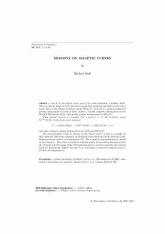
- Consulter un extrait
- Année : 2012
- Tome : 36
- Format : Électronique
- Langue de l'ouvrage :
Anglais - Class. Math. : 11G05, 14H52
- Pages : 151-179
Soit $E$ une courbe elliptique sur $\mathbb Q$ (ou, plus généralement, sur un corps de nombres quelconque). On lui associe, d'une part, le groupe abélien de type fini $E(\mathbb Q)$, et d'autre part, le groupe de Shafarevich-Tate $III$ $(\mathbb Q, E)$. La descente est une méthode générale pour obtenir des informations sur ces deux objets - idéalement des informations complètes sur le groupe de Mordell-Weil $E(\mathbb Q)$, et typiquement des informations partielles sur $III$ $(\mathbb Q, E)$. Une descente calcule (pour un $n > 1$ donné) le $n$-groupe de Selmer $\operatorname{Sel}^{(n)}(\mathbb Q, E)$, qui se trouve dans une suite exacte \[ 0 \longrightarrow E(\mathbb Q)/nE(\mathbb Q) \longrightarrow \operatorname{Sel}^{(n)}(\mathbb Q, E) \longrightarrow III (\mathbb Q, E)[n] \longrightarrow 0 \] et qui contient donc des informations combinées sur $E(\mathbb Q)$ et sur $III$ $(\mathbb Q, E)$. Le sujet principal que de ce mini-cours est de rendre explicite cette descente, et en particulier, de représenter les éléments du groupe de Selmer comme des courbes couvrant~$E$. Ces représentations explicites sont utiles à deux égards : elles permettent de chercher des points rationnels (en cas de succès, l'élément est dans l'image de $E(\mathbb Q)/n E(\mathbb Q)$); et elles fournissent un point de départ pour effectuer des descentes d'ordre plus élevé (par exemple, une $p^2$-descente suivant une $p$-descente).

